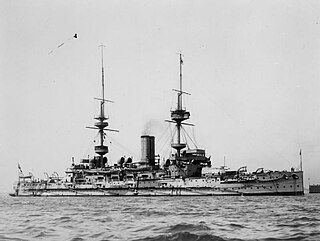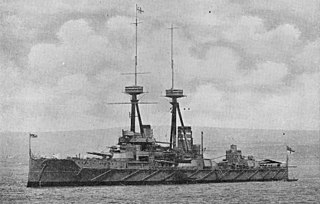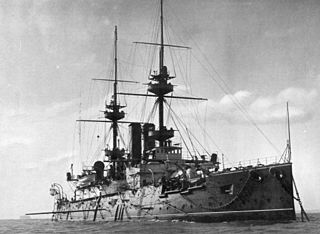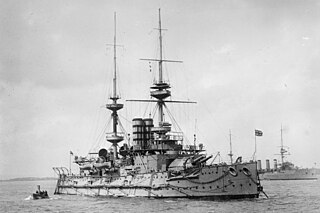This article needs additional citations for verification .(February 2024) |
The list of ship commissionings in 1914 includes a chronological list of all ships commissioned in 1914.
This article needs additional citations for verification .(February 2024) |
The list of ship commissionings in 1914 includes a chronological list of all ships commissioned in 1914.

The third HMS Illustrious of the British Royal Navy was a Majestic-class pre-dreadnought battleship. The ship was built at the Chatham Dockyard; her keel was laid down in March 1895, her completed hull was launched in September 1896, and she was commissioned into the fleet in April 1898. She was armed with a main battery of four 12-inch (305 mm) guns and a secondary battery of twelve 6-inch (152 mm) guns. The ship had a top speed of 16 knots.

HMS Neptune was a dreadnought battleship built for the Royal Navy in the first decade of the 20th century, the sole ship of her class. She was the first British battleship to be built with superfiring guns. Shortly after her completion in 1911, she carried out trials of an experimental fire-control director and then became the flagship of the Home Fleet. Neptune became a private ship in early 1914 and was assigned to the 1st Battle Squadron.

HMS St Vincent was the lead ship of her class of three dreadnought battleships built for the Royal Navy in the first decade of the 20th century. After commissioning in 1910, she spent her whole career assigned to the Home and Grand Fleets, often serving as a flagship. Aside from participating in the Battle of Jutland in May 1916, during which she damaged a German battlecruiser, and the inconclusive action of 19 August several months later, her service during World War I generally consisted of routine patrols and training in the North Sea. The ship was deemed obsolete after the war and was reduced to reserve and used as a training ship. St Vincent was sold for scrap in 1921 and broken up the following year.

The Town class was a group of twenty-one light cruisers built for the Royal Navy (RN) and Royal Australian Navy (RAN) of the first half of the 20th century. These vessels were long-range cruisers, suitable for patrolling the vast expanse covered by the British Empire. These ships, initially rated as second class cruisers, were built to a series of designs, known as the Bristol, Weymouth, Chatham, Birmingham and Birkenhead classes – all having the names of British towns except for the RAN ships, which were named after Australian cities.

HMS Majestic was a Majestic-class pre-dreadnought battleship of the Royal Navy. Commissioned in 1895, she was the largest pre-dreadnought launched at the time. She served with the Channel Fleet until 1904, following which she was assigned to the Atlantic Fleet. In 1907, she was part of the Home Fleet, firstly assigned to the Nore Division and then with the Devonport Division. From 1912, she was part of the 7th Battle Squadron.

HMS Victorious was one of nine Majestic-class pre-dreadnought battleships of the British Royal Navy. She was armed with a main battery of four 12-inch (305 mm) guns in two twin turrets, and was capable of a top speed of 16 knots. She served primarily on home waters, and participated in the Fleet Review for the Diamond Jubilee for Queen Victoria in 1897. She served briefly in the Mediterranean in 1898 before being transferred to the China Station later that year; Victorious remained in East Asian waters until 1900, when she returned to the Mediterranean.

HMS Jupiter was a Majestic-class pre-dreadnought battleship of the Royal Navy. Commissioned in 1897, she was assigned to the Channel Fleet until 1905. After a refit, she was temporarily put in reserve before returning to service with the Channel Fleet in September 1905. In 1908 and rendered obsolete by the emergence of the dreadnought type of battleships, she once again returned to the reserve, this time with the Home Fleet. After another refit, she had a spell as a gunnery training ship in 1912.

HMS Britannia was a King Edward VII-class pre-dreadnought battleship of the Royal Navy. She was named after Britannia, the Latin name of Great Britain under Roman rule. The ship was built by Portsmouth Dockyard between 1904 and 1906. Armed with a battery of four 12-inch (305 mm) and four 9.2 in (234 mm) guns, she and her sister ships marked a significant advance in offensive power compared to earlier British battleship designs that did not carry the 9.2 in guns.

HMS Castor was one of the Cambrian subclass of the C class of light cruisers. She saw service during the First World War and the Russian Civil War.

SS Southern Cross was a steam-powered sealing vessel that operated primarily in Norway and Newfoundland.

W. T. Preston is a specialized sternwheeler that operated as a snagboat, removing log jams and natural debris that prevented river navigation on several Puget Sound-area rivers. She is now the centerpiece of the Snagboat Heritage Center in Anacortes, Washington. She was designated a National Historic Landmark in 1989. Built in 1929, she is one of two surviving snagboats built and operated by the United States Army Corps of Engineers, and the only one on the American west coast.

HMS Queen was a member of the London class of pre-dreadnought battleships built for the British Royal Navy. The Londons were near repeats of the preceding Formidable-class battleships, but with modified armour protection. Due to slight differences between Queen and HMS Prince of Wales and the other Londons, they are sometimes referred to as the Queen class. The ship's main battery consisted of four 12-inch (305-mm) guns, and she had top speed of 18 knots. The ship was laid down in March 1901, was launched in March 1902, and was completed in March 1904. After commissioning in April 1904, she served with the Mediterranean Fleet until 1906, when she returned to Britain before embarking on another stint with the Mediterranean Fleet later that year. Queen was transferred back to the United Kingdom in 1908 and thereafter served in the Atlantic Fleet, the Home Fleet, and finally the 5th Battle Squadron of the Second Fleet in 1914.

HMS Russell was a Duncan-class pre-dreadnought battleship of the Royal Navy commissioned in 1903. Built to counter a group of fast Russian battleships, Russell and her sister ships were capable of steaming at 19 knots, making them the fastest battleships in the world. The Duncan-class battleships were armed with a main battery of four 12-inch (305 mm) guns and they were broadly similar to the London-class battleships, though of a slightly reduced displacement and thinner armour layout. As such, they reflected a development of the lighter second-class ships of the Canopus-class battleship. Russell was built between her keel laying in March 1899 and her completion in February 1903.

HMS Centaur was a C-class light cruiser of the Royal Navy that served in the First World War and the Russian Civil War. She was the name ship of the Centaur group of the C-class of cruisers.

HMS Canterbury was a C-class light cruiser of the Royal Navy that saw service in the First World War and the Russian Civil War. She was part of the Cambrian group of the C class.

HMS Champion was a C-class light cruiser of the Royal Navy that saw service during World War I. She was part of the Calliope group of the C class.

HMS Mars was a Royal Navy pre-dreadnought battleship of the Majestic class, the seventh member of a class of nine ships. The ship was laid down in the Laird Brothers shipyard in June 1894, she was launched in March 1896, and she was commissioned into the fleet in June 1897. She was armed with a main battery of four 12-inch (305 mm) guns and a secondary battery of twelve 6-inch (152 mm) guns. The ship had a top speed of 16 knots.

The first HMS Walrus (D24) was a W-class destroyer of the British Royal Navy that saw service in the final months of World War I.